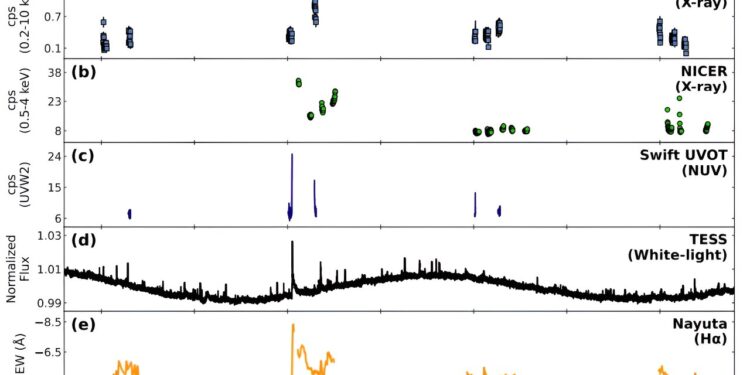Light curves over four days of EV Lacertae during our observation campaign from October 24 to 27, 2022. Credit: arXiv (2024). DOI: 10.48550/arxiv.2401.00399
Astronomers have made multi-wavelength observations of a nearby M dwarf star known as EV Lacertae (or EV Lac for short). The observation campaign resulted in the detection of a new large stellar flare coming from this object. The discovery was detailed in a paper published Dec. 31 on the preprint server. arXiv.
Stellar flares are energetic, impulsive releases of large amounts of energy from a star. They occur when a change in the star’s magnetic field accelerates electrons to speeds close to that of light, resulting in flares producing emissions across the electromagnetic spectrum.
Observations show that flares of M dwarf stars provide some of the most dramatic stellar events; however, they are difficult to predict. Spotting such activity on this type of object requires long-term measurements on many stars.
Now, a team of astronomers led by Shun Inoue of Kyoto University in Japan reports the detection of a new flare from such a star. In October 2022, they carried out multi-wavelength observations of EV Lacertae (also known as GJ 873), an active and faint M dwarf of spectral type M4.5 located approximately 16.5 years away. light.
“We performed 4-night multi-wavelength observations of an active M dwarf star EV Lacertae from October 24 to 27, 2022 with simultaneous soft X-ray coverage (NICER; 0.2−12 keV, Swift XRT ; 0.2−10 keV), near -ultraviolet (Swift UVOT/UVW2; 1,600−3,500 Å), optical photometry (TESS; 6,000−10,000 Å) and optical spectroscopy (Nayuta/MALLS; 6,350− 6,800 Å),” the researchers wrote in the paper.
During the observation campaign, a significant eruption of EV Lacertae was detected on October 25. The flare had a white light bolometric energy of approximately 0.34 decillion ergs and its X-ray bolometric energy was calculated to be at a level of 0.92 decillion ergs.
Observations show that the eruption was followed by an excess blue-shifted component of the alpha spectrum of hydrogen, with a speed of around 100 km/s. Astronomers assume that this component, which occurred about an hour after the eruption, can be attributed to a prominence eruption.
According to the study, the near-ultraviolet and white light curves of EV Lacertae show gradual and rapid brightening during the ascending phase of the eruption. It was noted that even during the gradual increase in white light, the near ultraviolet (NUV) emission had already increased rapidly. The ratio of near-ultraviolet light to white light flux at the peak during the progressive phase was calculated to be approximately 0.49.
The study authors plan to further study the EV Lacertae eruption by combining multi-band radio and optical photometric data. They will publish their results in future research articles.
More information:
Shun Inoue et al, Multi-wavelength observation of an active M dwarf star EV Lac and its stellar flare accompanied by a delayed prominence flare, arXiv (2024). DOI: 10.48550/arxiv.2401.00399
Journal information:
arXiv
© 2024 Science X Network
Quote: New large stellar flare detected from EV Lacertae (January 10, 2024) retrieved on January 10, 2024 on
This document is subject to copyright. Apart from fair use for private study or research purposes, no part may be reproduced without written permission. The content is provided for information only.



